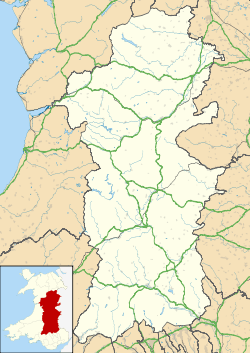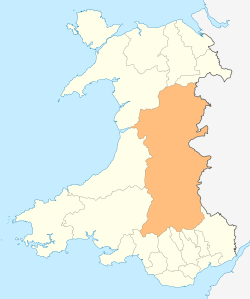Llanwrtyd
| Llanwrtyd | |
|---|---|
| Parish | |
| Ecclesiastical Parish of Llanwrtyd | |
 Llanwrtyd Location in Powys | |
| Coordinates: 52°06′57″N 3°39′43″W / 52.11589°N 3.66193°WCoordinates: 52°06′57″N 3°39′43″W / 52.11589°N 3.66193°W | |
| Country | Wales |
| Local government county | Powys |
| Historic county | Brecknockshire |
| Diocese | Swansea and Brecon |
| Dedication | St David |
| OS grid reference | SN862478 |
| Deposited registers | 1748-1991 |
Llanwrtyd is a rural ecclesiastical parish in Powys, mid-Wales, in the historic county of Brecknockshire (Breconshire) through which flows the River Irfon.
The parish church of St David dates from the 11th century and is surrounded by scattered farms. During the 19th century the main population centre became Llanwrtyd Wells which grew up around the sulphur springs about a mile and a half down river from the church.
The town is served by Llanwrtyd railway station.
Origin of the name
The name Llanwrtyd combines the term for church ("llan") and an otherwise undocumented personal name Gwrtud or Gwrtyd, but the earliest reference to it "Llanworted" appears only in 1543. It is speculated that the original dedication of the church has been replaced by the present one to the more famous saint in whose diocese it was during the Middle Ages.[1] The name is more traditionally derived, however, from 'Llanddewi wrth y rhyd' (David's church by the ford).[2] The church is held to have been founded by St David in the 6th century. The curving boundary around the west side of the churchyard and its location beside the river supports the contention that it was established well before the Norman Conquest. The church was classed as a chapel attached to Llangammarch.[1]
History
Theophilus Jones, in his A History of the County of Brecknock, was fairly disparaging of the parish; when describing the church he states "there is nothing deserving of notice in this miserable fabric, unless it be an inscription on the wall, to the memory of an old woman of the name of Jones."
In 1740 the curate in the parishes of Llanwrtyd, Llanfihangel Abergwesyn and Llanddewi Abergwesyn, was Wales' most famous hymn-writer William Williams Pantycelyn.[3]
The population in 1801 was about 500 which had risen to 854 by the 1901 census. After the coming of the railway the parish played host to at least 12,000 visitors annually to drink the mineral waters.
The parish of Llanwrtyd was made separate from that of Llangammarch in 1871. The parish church of St David, which now stands next to a bridge that replaced the earlier ford, was restored in 1862. In 1897 the church of St James was built in the village of Llanwrtyd Wells.
References
- 1 2 "Clwyd Powys Archaeological Trust" (PDF). Retrieved 14 October 2018.
- ↑ Morgan, Rev Thomas (1887). "HANDBOOK OF THE ORIGIN OF PLACE-NAMES IN WALES AND MONMOUTHSHIRE" (PDF). Retrieved 14 October 2018.
- ↑ "Poetry by William Williams, Pantycelyn (NLW MS 77A)" at llgc.org.uk Archived 2012-05-07 at the Wayback Machine.
